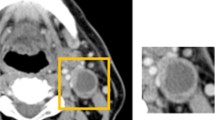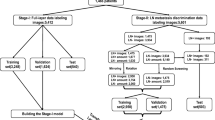Abstract
Objective
To apply a deep learning object detection technique to CT images for detecting cervical lymph nodes metastasis in patients with oral cancers, and to clarify the detection performance.
Methods
One hundred and fifty-nine metastatic and 517 non-metastatic lymph nodes on 365 CT images in 56 patients with oral squamous cell carcinoma were examined. The images were arbitrarily assigned to training, validation, and testing datasets. Using the neural network, ‘DetectNet’ for object detection, the training procedure was conducted for 1000 epochs. Testing image datasets were applied to the learning model, and the detection performance was calculated.
Results
The learning curve indicated that the recall (sensitivity) for detecting metastatic and non-metastatic lymph nodes reached 90% and 80%, respectively, while the model performance recall by applying the test dataset was 73.0% and 52.5%, respectively. The recall for detecting level IB and Level II metastatic lymph nodes was relatively high.
Conclusions
A system that has the potential to automatically detect cervical lymph nodes was constructed.





Similar content being viewed by others
References
de Bondt RB, Nelemans PJ, Hofman PA, Casselman JW, Kremer B, van Engelshoven JM, et al. Detection of lymph node metastases in head and neck cancer: a meta-analysis comparing US, USgFNAC, CT and MR imaging. Eur J Radiol. 2007;64:266–72.
Roh JL, Park JP, Kim JS, Lee JH, Cho KJ, Choi SH, et al. 18F fluorodeoxyglucose PET/CT in head and neck squamous cell carcinoma with negative neck palpation findings: a prospective study. Radiology. 2014;271:153–61.
Zheng E, Khariwala SS. Do all patients with head and neck cancer require a positron emission tomography scan at diagnosis? Laryngoscope. 2019;129:537–8.
Dong F, Tao C, Wu J, Su Y, Wang Y, Wang Y, et al. Author correction: detection of cervical lymph node metastasis from oral cavity cancer using a non-radiating, noninvasive digital infrared thermal imaging system. Sci Rep. 2018;8:10624.
Goel R, Moore W, Sumer B, Khan S, Sher D, Subramaniam RM. Clinical practice in PET/CT for the management of head and neck squamous cell cancer. AJR Am J Roentgenol. 2017;209:289–303.
Beheshtian E, Sahraian S, Yousem DM, Khan MK. Incidental findings on cervical spine computed tomography scans: overlooked and unimportant? Neuroradiology. 2018;60:1175–80.
Ng SH, Yen TC, Chang JT, Chan SC, Ko SF, Wang HM, et al. Prospective study of [18F] fluorodeoxyglucose positron emission tomography and computed tomography and magnetic resonance imaging in oral cavity squamous cell carcinoma with palpably negative neck. J Clin Oncol. 2006;24:4371–6.
Liu H, Xu Q, Lin F, Ma J. Hepatocellular carcinoma metastasis to the mandibular ramus: a case report. Int J Clin Exp Pathol. 2019;12:1047–51.
Del Ciello A, Franchi P, Contegiacomo A, Cicchetti G, Bonomo L, Larici AR. Missed lung cancer: when, where, and why? Diagn Interv Radiol. 2017;23:118–26.
Lee KS, Jung SK, Ryu JJ, Shin SW, Choi J. Evaluation of transfer learning with deep convolutional neural networks for screening osteoporosis in dental panoramic radiographs. J Clin Med. 2020. https://doi.org/10.3390/jcm9020392.
Lee JH, Han SS, Kim YH, Lee C, Kim I. Application of a fully deep convolutional neural network to the automation of tooth segmentation on panoramic radiographs. Oral Surg Oral Med Oral Pathol Oral Radiol. 2019. https://doi.org/10.1016/j.oooo.2019.11.007.
Kunz F, Stellzig-Eisenhauer A, Zeman F, Boldt J. Artificial intelligence in orthodontics: evaluation of a fully automated cephalometric analysis using a customized convolutional neural network. J Orofac Orthop. 2020;81:52–68.
Ariji Y, Yanashita Y, Kutsuna S, Muramatsu C, Fukuda M, Kise Y, et al. Automatic detection and classification of radiolucent lesions in the mandible on panoramic radiographs using a deep learning object detection technique. Oral Surg Oral Med Oral Pathol Oral Radiol. 2019;128:424–30.
Fukuda M, Inamoto K, Shibata N, Ariji Y, Yanashita Y, Kutsuna S, et al. Evaluation of an artificial intelligence system for detecting vertical root fracture on panoramic radiography. Oral Radiol. 2019. https://doi.org/10.1007/s11282-019-00409-x.
Som PM, Curtin HD, Mancuso AA. Imaging-based nodal classification for evaluation of neck metastatic adenopathy. AJR Am J Roentgenol. 2000;174:837–44.
Yonetsu K, Sumi M, Izumi M, Ohki M, Eida S, Nakamura T. Contribution of doppler sonography blood flow information to the diagnosis of metastatic cervical nodes in patients with head and neck cancer: assessment in relation to anatomic levels of the neck. AJNR Am J Neuroradiol. 2001;22:163–9.
Tao A, Barker J, Sarathy S. DetectNet: deep neural network for object detection in DIGITS. 2016. Available at: https://devblogs.nvidia.com/detectnet-deep-neural-network-object-detection-digits/
Ariji Y, Fukuda M, Kise Y, Nozawa M, Yanashita Y, Fujita H, et al. Contrast-enhanced computed tomography image assessment of cervical lymph node metastasis in patients with oral cancer by using a deep learning system of artificial intelligence. Oral Surg Oral Med Oral Pathol Oral Radiol. 2019;127:458–63.
Ariji Y, Sugita Y, Nagao T, Nakayama A, Fukuda M, Kise Y, et al. CT evaluation of extranodal extension of cervical lymph node metastases in patients with oral squamous cell carcinoma using deep learning classification. Oral Radiol. 2020;36:148–55.
Lee JH, Ha EJ, Kim D, Jung YJ, Heo S, Jang YH, et al. Application of deep learning to the diagnosis of cervical lymph node metastasis from thyroid cancer with CT: external validation and clinical utility for resident training. Eur Radiol. 2020. https://doi.org/10.1007/s00330-019-06652-4.
Lee JH, Ha EJ, Kim JH. Application of deep learning to the diagnosis of cervical lymph node metastasis from thyroid cancer with CT. Eur Radiol. 2019;29:5452–7.
Chen L, Zhou Z, Sher D, Zhang Q, Shah J, Pham NL, et al. Combining many-objective radiomics and 3D convolutional neural network through evidential reasoning to predict lymph node metastasis in head and neck cancer. Phys Med Biol. 2019;64:075011.
Zhou Z, Chen L, Sher D, Zhang Q, Shah J, Pham NL, et al. Predicting lymph node metastasis in head and neck cancer by combining many-objective radiomics and 3-dimensioal convolutional neural network through evidential reasoning. Conf Proc IEEE Eng Med Biol Soc. 2018;2018:1–4. https://doi.org/10.1109/EMBC.2018.8513070.
Kann BH, Aneja S, Loganadane GV, Kelly JR, Smith SM, Decker RH, et al. Pretreatment identification of head and neck cancer nodal metastasis and extranodal extension using deep learning neural networks. Sci Rep. 2018;8:14036.
Szegedy C, Liu W, Jia Y, Sermanet P, Reed S, Anguelov D, et al. Going Deeper with Convolutions. IEEE Conference on Computer Vision and Pattern Recognition (CVPR), 2015, pp. 1–9. Available at: https://www.cv-foundation.org/openaccess/content_cvpr_2015/html/Szegedy_Going_Deeper_With_2015_CVPR_paper.html
Al-Masni MA, Al-Antari MA, Park JM, Gi G, Kim TY, Rivera P, et al. Simultaneous detection and classification of breast masses in digital mammograms via a deep learning YOLO-based CAD system. Comput Methods Programs Biomed. 2018;157:85–94.
Wu W, Yin Y, Wang X. Face detection with different scales based on faster R-CNN. IEEE Trans Cybern. 2019;49:4017–28.
Yu J, Schumann AW, Cao Z, Sharpe SM, Boyd NS. Weed detection in perennial ryegrass with deep learning convolutional neural network. Front Plant Sci. 2019;10:1422. https://doi.org/10.3389/fpls.2019.01422.
Yu J, Sharpe SM, Schumann AW, Boyd NS. Detection of broadleaf weeds growing in turfgrass with convolutional neural networks. Pest Manag Sci. 2019;75:2211–8.
Kakei Y, Komatsu H, Minamikawa T, Hasegawa T, Teshima M, Shinomiya H, et al. Extent of neck dissection for patients with clinical N1 oral cancer. Int J Clin Oncol. 2020. https://doi.org/10.1007/s10147-020-01635-8.
Sugiyama S, Iwai T, Izumi T, Ishiguro K, Baba J, Oguri S, et al. CT lymphography for sentinel lymph node mapping of clinically N0 early oral cancer. Cancer Imaging. 2019;19:72. https://doi.org/10.1186/s40644-019-0258-9.
Acknowledgements
We thank H. Nikki March, PhD, from Edanz Group (https://jp-author-services.edanzgroup.com/) for editing a draft pf this manuscript.
Author information
Authors and Affiliations
Corresponding author
Ethics declarations
Conflict of interest
Yoshiko Ariji, Motoki Fukuda, Michihito Nozawa, Chiaki Kuwada, Mitsuo Goto, Kenichiro Ishibashi, Atsushi Nakayama, Yoshihiko Sugita,Toru Nagao, and Eiichiro Ariji declare that they have no conflicts of interest.
Human rights statements and informed consent
All procedures were performed in accordance with the ethical standards of the responsible committee on human experimentation (institutional and national) and with the Helsinki Declaration of 1964 and later versions.
Animal rights statement
This article does not contain any studies with animal subjects performed by any of the authors.
Additional information
Publisher's Note
Springer Nature remains neutral with regard to jurisdictional claims in published maps and institutional affiliations.
Rights and permissions
About this article
Cite this article
Ariji, Y., Fukuda, M., Nozawa, M. et al. Automatic detection of cervical lymph nodes in patients with oral squamous cell carcinoma using a deep learning technique: a preliminary study. Oral Radiol 37, 290–296 (2021). https://doi.org/10.1007/s11282-020-00449-8
Received:
Accepted:
Published:
Issue Date:
DOI: https://doi.org/10.1007/s11282-020-00449-8




